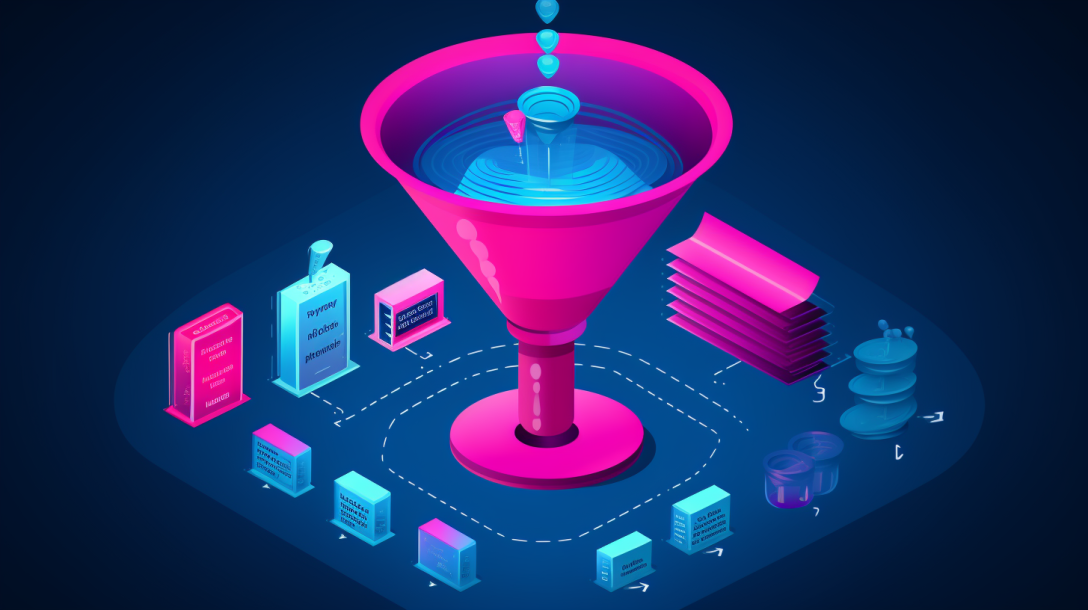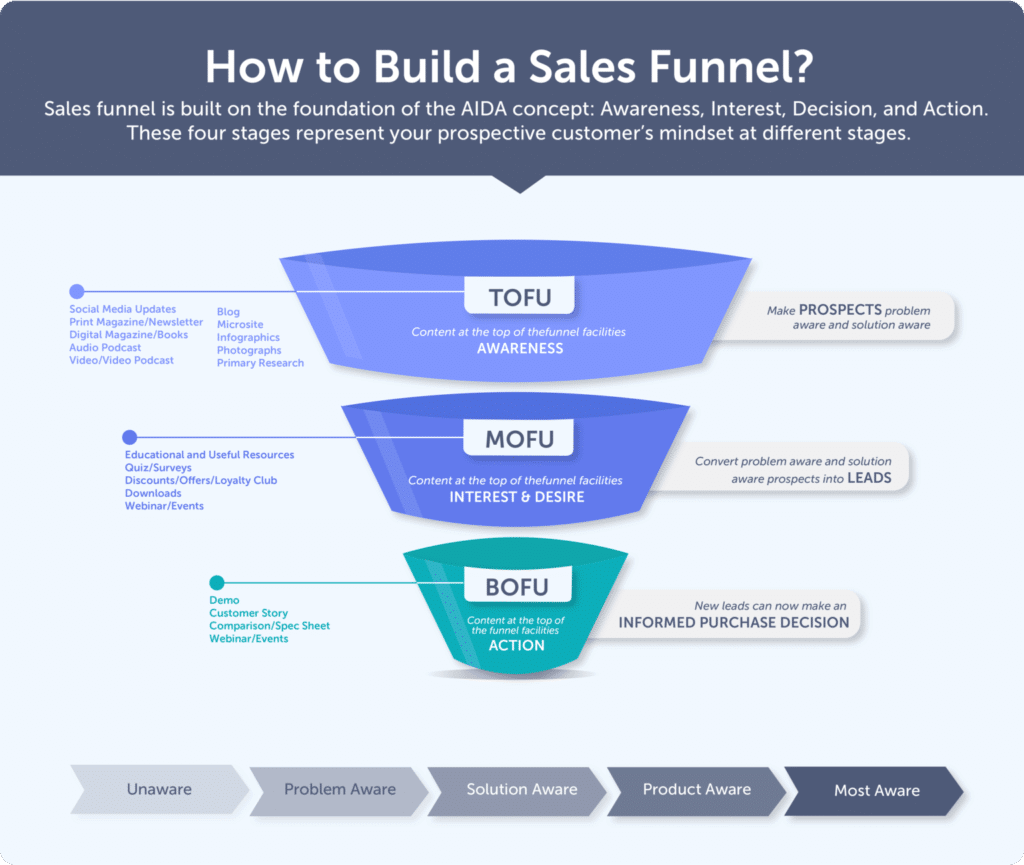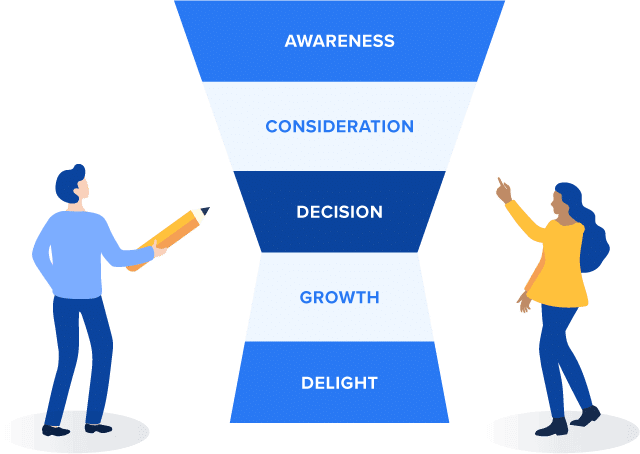How to Create a B2B Sales Funnel (with Free Template Download)

The B2B buyers’ journey can be a long one, with plenty of winding turns. When a company is looking for critical equipment or an enterprise software solution, the purchasing process can take many months and involve multiple decision-makers within the organization.
This journey poses challenges for sales and marketing teams. It doesn’t do much good to serve up content that shows off your product’s best features. Why? Because that buyer is already familiar with your product’s best features and is just looking for reasons to choose you over your competitors. Fortunately, there’s a handy metaphor that helps businesses present the right content and messaging to the right targets at the right time: the sales funnel.
A sales funnel can be an indispensable tool for planning a marketing campaign and choosing a balanced content selection for the audiences you’re trying to reach. When B2B buyers finalize a deal, nearly nine out of ten reports being influenced by content that was directly relevant to where they were at in their purchasing process.
This article will explain exactly how the sales funnel model works and why it’s important for B2B marketers to have one. We’ll also provide you with a downloadable B2B sales funnel template you can use for planning and strategizing a funnel for your business.
What is a B2B Sales Funnel, and how does it work?
The sales funnel is a method of visualizing the process by which a customer becomes aware of a solution, learns more about it, and decides to go ahead and purchase it.
Sales funnels can best be visualized as stages in a vertical funnel, with the narrow end at the bottom.

The top of the funnel (TOFU) is wide: it’s where all of your potential sales prospects first gain awareness of your company and the solutions you offer. The TOFU is where your content should have the broadest appeal.
In the middle of the funnel (MOFU): leads who are interested in your solutions and have taken steps to interact with you can continue their research with more in-depth content. Here, the funnel narrows. Not all of your prospects who reach this stage will convert.
The bottom of the funnel (BOFU): narrows even further, containing only those leads who are ready to make a purchase decision. Here, account-based marketing and personalized content are at their most effective. The BOFU is where you need to speak directly to your buyers’ specific concerns and questions.
There are different ways to model a sales funnel. The classic AIDA model divides the funnel into five stages: Attention, Interest, Decision, and Action. More recent models consider the customer interactions that can happen after a sale is made, and may be represented as more of an hourglass shape. If your B2B depends on loyal customers and repeat sales, it may be helpful to use this type of model.
Why You Need a B2B Sales Funnel
A marketing campaign succeeds or fails based on the effectiveness of the content it delivers. Situating your content strategy within the context of a sales funnel can help ensure you’re providing the right content at the perfect time. It also calls attention to any gaps or shortcomings in your strategy.
For example, you might have excellent viral videos that generate buzz about your solution and explain the basics of what it does. You might also have a brilliant sales team armed with customer testimonials and case studies that are super effective at closing deals. But if you look at where these resources would be placed in your sales funnel, it’s clear that your MOFU stages are empty. You’ll still make sales from leads who do their own research and enter the funnel at the bottom. But you’re not doing anything to move your freshly-converted prospects down further into the funnel.
One study found that 68% of companies have made no attempt to measure or identify their sales funnel. A sales funnel offers strategic advantages in delivering the content most likely to increase your conversion rates, improves your sales forecasting, and gets a higher ROI on your marketing dollar.
5 Stages of a B2B Sales Funnel
The sales funnel’s top, middle, and bottom can be broken down into stages that describe where the customer is at in their purchasing journey and what actions you should take to address their needs at that stage. The stages may vary depending on the model you use.
Stage 1 – Awareness
Right up at the TOFU is the awareness stage, where prospects become aware they have a problem and start looking for a solution. Here is where you want to deploy marketing materials that introduce audiences to your company and the products or services you offer. Many prospects will bounce out of this stage. But if you understand their pain points and show them that you can provide the solution they’re looking for, you can lead them down to the next stage. Inbound and outbound marketing strategies can both be effective here.
Stage 2 – Consideration
Once a lead is interested in your solution and wants to learn more, you can start using lead generation tactics to fill out their personas and open up direct communication channels. Now you can start offering detailed MOFU content to the individuals within the buyer’s organization who are doing the research. This time is best used to educate leads about your unique value propositions. You want to prove that you can address their pain points and solve the issues that led them into your funnel in the first place.

Stage 3 – Decision
Down at the BOFU, leads more or less know what you’re offering. They have evaluated your strengths and weaknesses, and are deciding whether to commit to making a purchase. Here, you must identify any lingering concerns or sticking points and do the best you can to resolve them. Personalization is crucial at this stage because you need to make a convincing case to everyone with decision-making authority – but each person will have their own concerns and priorities. In-person sales presentations, case studies and success stories from other customers, and trial offers may be appropriate tactics at this point.
Stage 4 – Growth
At this post-BOFU stage, you’ve got buyers who have already purchased from you and are starting to make use of your solution. It’s critical to provide adequate onboarding and support at this stage so that your customer has a positive experience. If all goes well, you may have opportunities for upselling here.
Stage 5 – Delight
A happy customer is a loyal customer. They will keep using your solutions, and purchase updates and add-ons. If they’re really satisfied, they may even become your advocates. Keep your customers feeling delighted with you by continuing to offer support and rewards. Don’t forget to solicit feedback to ensure you’re continuing to meet their evolving needs. If you’ve developed a strong enough customer relationship, you can ask if they would provide a positive customer testimonial or agree to appear in a case study.
How to Use the B2B Sales Funnel Template
The B2B sales funnel template provides you with a sales funnel diagram with space to write down your buyer personas, overall strategy, and specific tactics for each stage in the funnel.
For example, if you were selling tax preparation software, your buyer persona for the awareness stage might be “finance managers and CPAs.” Your overall strategy could be to get them to watch a video or read a blog post about your software. Your tactics could include SEO optimization, social media ads, and cold calls.
Once your template is filled out, you’ll have a road map for where and when to mobilize the various elements of your campaign. An at-a-glance review of your completed template will quickly reveal where your campaign might have insufficient coverage.
How to Make Your Funnel Leakproof
Now you’ve got a clear picture of how a sales funnel works and what forms it can take. You’ve heard why it’s important to have a sales funnel to manage the lengthy and complex B2B sales process. You’ve even have a sales funnel template to get you up and running. There’s just one last thing you need to know — how to keep your sales funnel from leaking.
When a lead is no longer likely to purchase from you and stops engaging with your content, it’s like your funnel has sprung a leak. An ongoing process of measuring results and optimizing your activities can minimize leaks, and having the right tools can make a huge difference.
Attribution-based personalization software can map out customer journeys, identify your pieces of content with the highest conversion rates, and serve up the right assets to the right customers at the most opportune moments. Targeted and customized content can plug the leaks in your funnel that disengaged leads slip through –and help you generate more conversions, sales, and revenue.